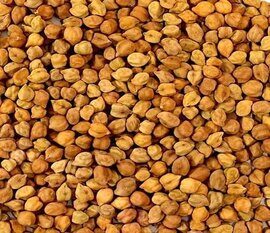Desi Chickpeas
The name chickpea comes from the Latin word cicer , referring to the plant family of legumes, Fabaceae. It is also known by its popular Spanish-derived name, the garbanzo bean. Kidney beans, black beans, lima beans, and peanuts are other familiar foods found in this legume family. These plants produce edible seeds, called pulses, that have high nutritional value. Two main varieties of chickpeas are the larger round light-colored. Kabuli-type, common in the United States, and the smaller dark irregularly shaped Desi-type often used in India, Bangladesh, Pakistan and the Middle East.

Source Of
· Protein
· Folate
· Fiber(Both insoluble and soluble)
· Iron
· Phosphorus
. Polyunsaturated and monounsaturated fatty acids including linoleic and oleic acids
Chickpeas and Health
Chickpeas and all pulses contain several components that, when eaten as part of a balanced plant-rich diet, may help prevent the development of various chronic diseases [1-7]
- Diabetes: Both dried and canned chickpeas have a low glycemic index and low glycemic load, and contain amylose, a resistant starch that digests slowly. These factors help to prevent sudden surges in blood sugar and insulin levels, which can improve overall blood sugar control in people with type 2 diabetes. [1-3,5-7]
- Gut Flora: Chickpeas contain a soluble fiber called raffinose, a type of oligosaccharide that is fermented in the colon by beneficial bacteria called Bifidobacterium. As bacteria break down this fiber, a short chain fatty acid called butyrate is produced. Butyrate plays a role in reducing inflammation in the cell wall of the colon, promoting regularity in the intestines, and possibly preventing colorectal cancer by promoting cell apoptosis (death). [1,3,4]
- Heart Disease: Chickpeas contain a plant sterol called sitosterol that is structurally similar to cholesterol in the body. It interferes with the body’s absorption of cholesterol and thereby can help to lower blood cholesterol levels. The fiber and unsaturated fats in chickpeas may also favorably affect blood lipid levels
TESCOM AUSTRALIA PTY LTD

